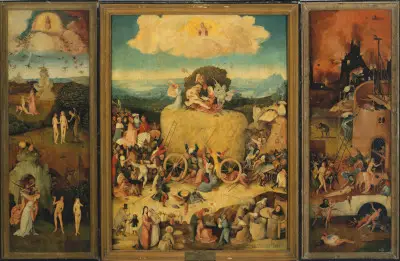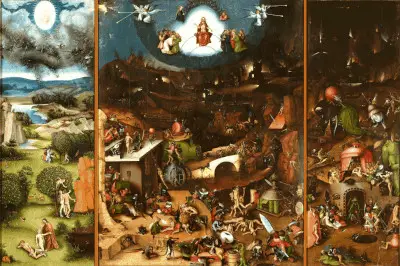Hieronymus Bosch's paintings featured an innovative combination of nightmare and fantasy, with creatures produced from the very depths of his imagination.
Introduction
Bosch's large-scale artworks, such as The Garden of Earthly Delights, provide a visual treat for the viewer in a way that no other artist has achieved. To consider his work against other famous names from the 15th and 16th centuries, he was truly unique in so many ways and his work continues to draw respect from art academics, designers and artists in the present day.
Indeed, a recent retrospective exhibition of his career in the Netherlands proved to be amongst the country's most visited art events in its history.
This artist's style does not fit with either the Flemish panel painters of this period, nor those who were influenced by the impact of the Italian Renaissance as it spread across the rest of the continent.
Albrecht Durer famously termed Bosch as a painter of dreams, pointing out how divergent this was from all others at that time. Even an artist as creative and ambitious as him was truly wowed by some of the output delivered by this North European colleague.
Long-lasting Legacy
Paintings by Hieronymus Bosch continue to fascinate art lovers and scholars 500 years after the artist’s death. His work has been described as many things, from heretical to pornographic and fantastical, but in all of his work, the scenes are detailed and complex and the viewer can see more the longer they look.
As little was recorded about Bosch and his life, it is difficult to understand with some certainty what influenced the painter. What is known is that his grandfather, father and uncles were all painters, but no artwork seems to have survived from these family members.
Hieronymus’s father, Anthonius van Aken, is recorded as being the artistic advisory to the Illustrious Brotherhood of Our Blessed Lady, a religious order in a nearby town. This family involvement with religion will have given Bosch a deep insight into the bible, which is the subject of most of his work.
Attributing his Work
There are few pieces of work that can be credited to Hieronymus Bosch with definite certainty. Only seven works were signed, and he did not date any of his art, so most of the information we have has been agreed through piecing together records surrounding the artist.
He produced triptychs, diptychs and polyptychs with some single panels, and nearly all were painted with oil on oak. The scenes depict religious stories, but with dreamlike and fantasy qualities that can be macabre and disturbing. As many of his paintings are made up of multiple parts, the scenes tell a story of warning.
The pieces often portray an ideal, followed by the reality, for example, or a before with an after scene. They have been described as a warning of what is to come if man gives into temptation.
Bosch seemed to clearly see the failings of mankind. He painted the temptations, sins and corruptness of people, including the inner feelings, fears and struggles that everyone fights with. The scenes demonstrate what might happen if people give in to those feelings and act upon them. The results are dark and hellish.
As he took these ideas further, he changed the images of people and gave them grotesque features, such as animal faces, tree-like limbs and contorted bodies. There are many images of heaven and hell, and man’s struggle between the two during his time on Earth.
Bosch's Most Famous Paintings
In his most famous painting, The Garden Of Earthly Delights, we can see all of these factors come together. This is a triptych, oil on oak, with an outer case that has a further scene visible when the case is closed. The outer painting is of the third day of creation, and is painted with a limited palette of colours - a grisaille of grey and dull green.
Inside, the three panels are more colourful and show the Garden of Eden in different stages of inhabitance - 1. the biblical ideal scene of innocence, 2. the struggles and temptations of man as the population grew, and 3. the fall of man from grace. In this work, the paint has been applied to the oak in a method not commonly used in 15th-century Netherlands. The oil has been drawn with, and applied slightly roughly, giving the work a watercolour quality.
Oil paint at this time was generally applied to create a smooth finish, one where brushstrokes were not visible. Bosch used muted colours which was typical of the day. Also, Flemish work of the time showed scenes of real life, whereas Bosch painted images purely from his imagination and was quite controversial.
Three Stages of his Development
The work of Bosch has been separated into three eras. His early work has been categorised as those completed 1470 to 1485, and his middle work was dated around 1485 to 1500. From 1500 until his death in 1516, his late period is considered his finest. Throughout his career, he fine-tuned his style and created creatures that can be described a surrealist, although this is ahead of that period.
Rabbit heads, crow features, pig snouts and tree arms are used to depict the ugly traits of man, and alien plant life, heavy with fruit demonstrates gluttony and greed. Musical instruments are thought to show man's lust for more, and the dark landscapes are there to serve a warning.
Bosch's Triptychs
Hieronymus Bosch paintings came about in the 15th and 16th century and this Dutch artist developed a career which was to become highly influential across European art. The popularity around his work would continue right up to the present day, many centuries later.
This website covers the full career of Bosch and presents images of his best known paintings. The Garden of Earthly Delights is certainly Bosch's most respected art work and you can see that included within this website. It was a highly detailed landscape triptych which can now be found in El Prado Museum.
This tripych is separated into three different paintings for each of the three sections, covering Adam and Eve on the left, earthly delights in the middle and hell to the right Bosch paintings attracted interest from right across the country and abroad in neighbouring areas with the artist receiving many impressive commissions as his reputation grew stronger and stronger.
Bosch used a style somewhat different to the normal Flemish style which was used at that time and this helped him to stand out from others who were simply following on from what had gone before. Changing tastes across Europe in the centuries which have passed since the career of Bosch means that his popularity has fluctuated, but currently he is seen as separate to the Dutch Golden Age because of his period of prominence but his importance to the art world is almost on a par with their greatest components. The best to have come from the Dutch Golden Age included Vermeer and Jan Steen.
Hell
Hieronymus Bosch had a style which many found unusual because of the way that he would create strange and wonderful fantasies whilst other artists of this time preferred to concentrate on what they considered reality. Many found the images within his paintings to be gruesome and not easy on the eye, but despite this Bosch still managed to achieve considerable success within his career.
There has been certain amounts of controversy over the attribution of paintings to Bosch because in part to the great amount of time that has passed by since his work came about. Bosch also rarely signed any paintings which has further complicated the matter and currently there are only around 25 paintings definitely confirmed as being from his own studio, and that comes from a career which lasted 30 to 40 years, meaning many more must be out there somewhere.
Temptation of St Anthony
Philip II of Spain was known to be the biggest fan of Bosch going and passionately bought up as many of his paintings as he could. This may explain why so many of this artist's work now reside within major art museums and galleries of Spain, with all the artist's roots of course being across in an area now referred to as the Netherlands.
Bosch used many moral and spiritual messages within his paintings and this is part of the reason that his career is now much loved as some are not as keen on the actual technical abilities that he had, with some critics arguing that his style was overly aggressive, even barbaric.
Tondals Vision
Bosch prints and posters are still very popular in the modern era, with this artist's reputation well suited to current tastes making their way around the European art world. Hieronymus Bosch's Garden of Earthly Delights is the most frequently reproduced of all his painting and typically his followers choose framed giclee art prints as they best match his original colour schemes and also a good frame is important for paintings of these styles.
All of the links within this website offer you the chance to buy high quality reproduction copies of original Bosch paintings from the Art.com gallery that covers his career in great detail, and has all of his attributed works available there at great prices. We regularly use their service ourselves so we are more than happy to recommend them to you.














































